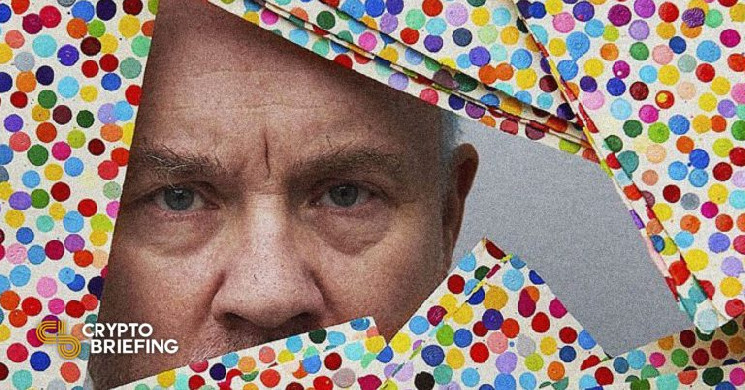Damien Hirst NFT Holders Divided as Half of Collection Burned

5,142 NFTs were exchanged for physical paintings, making the remaining digital pieces more scarce than their physical counterparts.
Damien Hirst’s Art Burning Deadline Closes
Damien Hirst fans seem to be divided on whether physical art is more valuable than digital art.
The burning deadline for the legendary artist’s first NFT collection closed today with just over half of the holders opting to redeem their digital collectible for a corresponding physical piece of art. 5,142 NFTs from the collection were exchanged for physical works, leaving 4,858 NFTs.

“Walk down the street” by Damien Hirst (Source: The Currency/HENI)
The 10,000-piece collection, dubbed The Currency, launched in July 2021 amid a boom in the NFT market. Created in 2016 and later minted on the Palm blockchain, the collection references the iconic polkadot style that Hirst pioneered. Hirst opted to make his first foray into the digital art space with a unique twist: anyone who bought one of the NFTs could choose to burn their token in exchange for an equivalent physical piece. Conversely, the physical work would be destroyed if the collector held onto their NFT.
“The Currency explores the boundaries of art and currency—when art changes and becomes a currency, and when currency becomes art,” the promotional copy for The Currency said. The collection went on sale with an entry price of $2,000; today the NFTs are worth the equivalent of around $7,500 on the secondary market (Hirst also rewarded collectors with a Thanksgiving airdrop based on his artwork for Drake’s Certified Lover Boy cover in November).
Although the collection experimented with determining the value of physical art against digital art, the outcome of the burning event indicates that Hirst collectors in the still-niche NFT market are largely undecided.
NFT Market Takes a Hit
While Hirst’s The Currency was the talk of the NFT space today, the broader market has suffered for months as crypto endures an extended winter period. Trading volumes on marketplaces like OpenSea have plummeted to 12-month lows as confidence in the space wanes and macroeconomic fears persist, while the floor prices for many top-tier collections have slid from their all-time highs alongside fungible crypto assets like Bitcoin and Ethereum. Bored Ape Yacht Club, the breakout star of the 2021 NFT bull run, topped a floor price of $436,000 in May; today the cheapest go for closer to $127,000 (The floor price for an ape has dropped from 156 ETH to 86 ETH, but ETH has also declined in dollar terms).
Damien Hirst is one of the world’s most renowned artists. He’s arguably best known for his various 1990s works that preserved dead animals, including “The Physical Impossibility of Death in the Mind of Someone Living,” which featured a 4-meter-long tiger shark in a formaldehyde-filled tank. He’s embraced NFTs since the market exploded in 2021, following up The Currency and its associated airdrop with a new collection called The Empresses earlier this year.
Disclosure: At the time of writing, the author of this piece owned some Otherside NFTs, ETH, and several other fungible and non-fungible cryptocurrencies.






 Bitcoin
Bitcoin  Ethereum
Ethereum  Tether
Tether  USDC
USDC  TRON
TRON  Dogecoin
Dogecoin  Cardano
Cardano  Bitcoin Cash
Bitcoin Cash  Chainlink
Chainlink  Zcash
Zcash  Monero
Monero  LEO Token
LEO Token  Stellar
Stellar  Litecoin
Litecoin  Hedera
Hedera  Dai
Dai  Cronos
Cronos  Tether Gold
Tether Gold  OKB
OKB  Ethereum Classic
Ethereum Classic  KuCoin
KuCoin  Gate
Gate  Algorand
Algorand  Cosmos Hub
Cosmos Hub  VeChain
VeChain  Dash
Dash  Tezos
Tezos  TrueUSD
TrueUSD  Stacks
Stacks  IOTA
IOTA  Decred
Decred  Basic Attention
Basic Attention  Theta Network
Theta Network  NEO
NEO  Synthetix
Synthetix  Qtum
Qtum  Ravencoin
Ravencoin  DigiByte
DigiByte  0x Protocol
0x Protocol  Nano
Nano  Zilliqa
Zilliqa  Siacoin
Siacoin  Numeraire
Numeraire  Waves
Waves  Hive
Hive  Ontology
Ontology  Status
Status  BUSD
BUSD  Enjin Coin
Enjin Coin  Pax Dollar
Pax Dollar  Lisk
Lisk  Steem
Steem  Huobi
Huobi  OMG Network
OMG Network  NEM
NEM  Bitcoin Gold
Bitcoin Gold  Augur
Augur  HUSD
HUSD